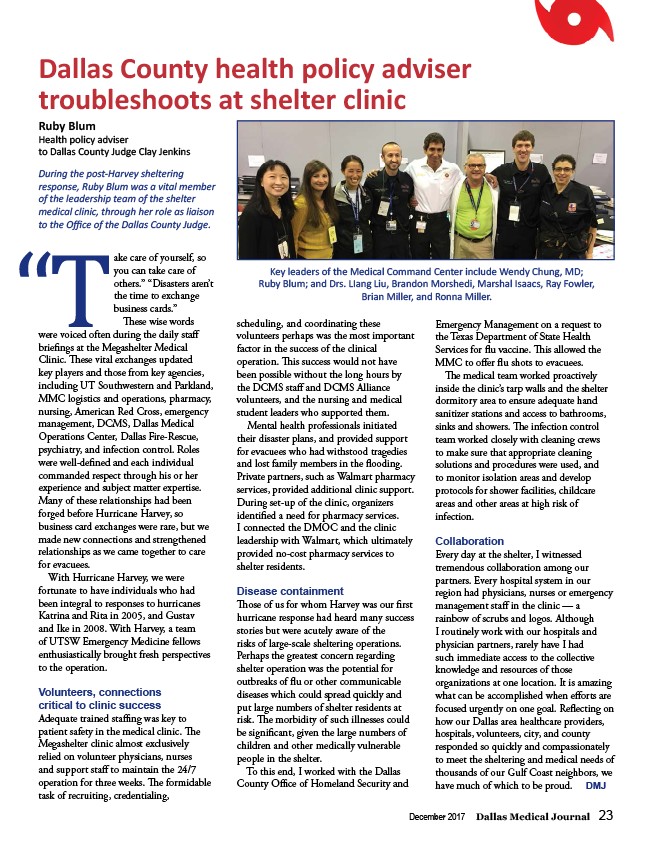
Dallas County health policy adviser
troubleshoots at shelter clinic
Ruby Blum
Health policy adviser
to Dallas County Judge Clay Jenkins
During the post-Harvey sheltering
response, Ruby Blum was a vital member
of the leadership team of the shelter
medical clinic, through her role as liaison
to the Offi ce of the Dallas County Judge.
Brian Miller, and Ronna Miller. “T
Key leaders of the Medical Command Center include Wendy Chung, MD;
Ruby Blum; and Drs. LIang Liu, Brandon Morshedi, Marshal Isaacs, Ray Fowler,
December 2017 Dallas Medical Journal 23
ake care of yourself, so
you can take care of
others.” “Disasters aren’t
the time to exchange
business cards.”
Th ese wise words
were voiced often during the daily staff
briefi ngs at the Megashelter Medical
Clinic. Th ese vital exchanges updated
key players and those from key agencies,
including UT Southwestern and Parkland,
MMC logistics and operations, pharmacy,
nursing, American Red Cross, emergency
management, DCMS, Dallas Medical
Operations Center, Dallas Fire-Rescue,
psychiatry, and infection control. Roles
were well-defi ned and each individual
commanded respect through his or her
experience and subject matter expertise.
Many of these relationships had been
forged before Hurricane Harvey, so
business card exchanges were rare, but we
made new connections and strengthened
relationships as we came together to care
for evacuees.
With Hurricane Harvey, we were
fortunate to have individuals who had
been integral to responses to hurricanes
Katrina and Rita in 2005, and Gustav
and Ike in 2008. With Harvey, a team
of UTSW Emergency Medicine fellows
enthusiastically brought fresh perspectives
to the operation.
Volunteers, connections
critical to clinic success
Adequate trained staffi ng was key to
patient safety in the medical clinic. Th e
Megashelter clinic almost exclusively
relied on volunteer physicians, nurses
and support staff to maintain the 24/7
operation for three weeks. Th e formidable
task of recruiting, credentialing,
scheduling, and coordinating these
volunteers perhaps was the most important
factor in the success of the clinical
operation. Th is success would not have
been possible without the long hours by
the DCMS staff and DCMS Alliance
volunteers, and the nursing and medical
student leaders who supported them.
Mental health professionals initiated
their disaster plans, and provided support
for evacuees who had withstood tragedies
and lost family members in the fl ooding.
Private partners, such as Walmart pharmacy
services, provided additional clinic support.
During set-up of the clinic, organizers
identifi ed a need for pharmacy services.
I connected the DMOC and the clinic
leadership with Walmart, which ultimately
provided no-cost pharmacy services to
shelter residents.
Disease containment
Th ose of us for whom Harvey was our fi rst
hurricane response had heard many success
stories but were acutely aware of the
risks of large-scale sheltering operations.
Perhaps the greatest concern regarding
shelter operation was the potential for
outbreaks of fl u or other communicable
diseases which could spread quickly and
put large numbers of shelter residents at
risk. Th e morbidity of such illnesses could
be signifi cant, given the large numbers of
children and other medically vulnerable
people in the shelter.
To this end, I worked with the Dallas
County Offi ce of Homeland Security and
Emergency Management on a request to
the Texas Department of State Health
Services for fl u vaccine. Th is allowed the
MMC to off er fl u shots to evacuees.
Th e medical team worked proactively
inside the clinic’s tarp walls and the shelter
dormitory area to ensure adequate hand
sanitizer stations and access to bathrooms,
sinks and showers. Th e infection control
team worked closely with cleaning crews
to make sure that appropriate cleaning
solutions and procedures were used, and
to monitor isolation areas and develop
protocols for shower facilities, childcare
areas and other areas at high risk of
infection.
Collaboration
Every day at the shelter, I witnessed
tremendous collaboration among our
partners. Every hospital system in our
region had physicians, nurses or emergency
management staff in the clinic — a
rainbow of scrubs and logos. Although
I routinely work with our hospitals and
physician partners, rarely have I had
such immediate access to the collective
knowledge and resources of those
organizations at one location. It is amazing
what can be accomplished when eff orts are
focused urgently on one goal. Refl ecting on
how our Dallas area healthcare providers,
hospitals, volunteers, city, and county
responded so quickly and compassionately
to meet the sheltering and medical needs of
thousands of our Gulf Coast neighbors, we
have much of which to be proud. DMJ